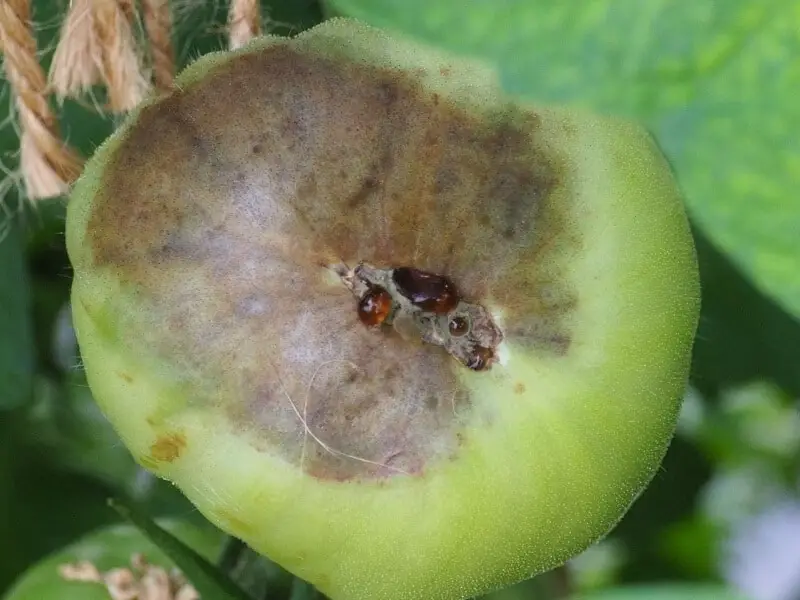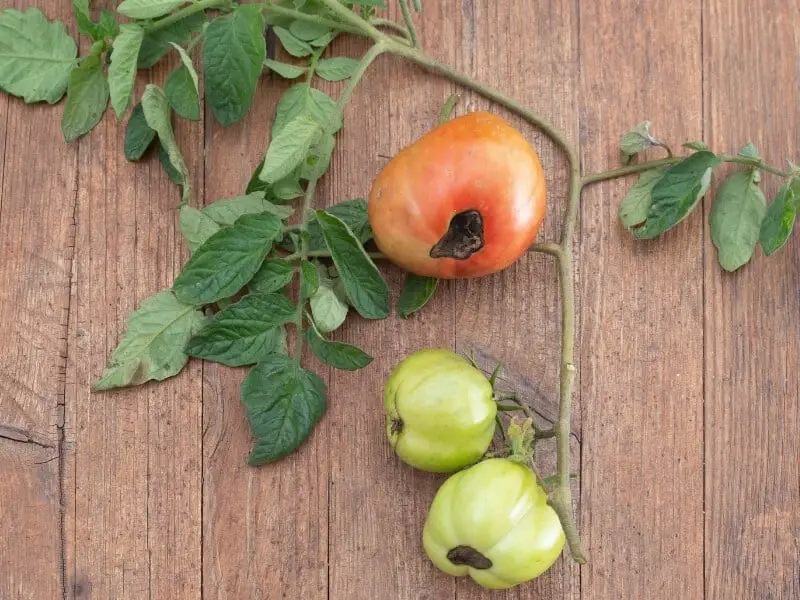Contents
Have you ever found ugly brown patches on the blossom section of your tomato fruits when the first harvest rolls in? Have you been wondering if it’s an infection or disease of some kind? Blossom End Rot (BER) can be quite worrisome and in this article, I’ll be explaining in detail what it is, how it is caused, and various procedures to follow to prevent it. I’ll also be debunking several myths about it.

Blossom end rot (BER) is a disorder that is commonly found in tomatoes that are grown in glasshouses or on fields. Studies have shown that it hardly occurs on wild tomatoes and large tomato varieties are more likely to have it. It is physically identified by the darkening and rotting of several parts of the fruit.
This darkening and rotting are believed to be caused by the death of the tomato cells due to a Calcium deficiency in the distal region of tomatoes. It begins to set in within two weeks of fruit formation and it mainly occurs at the first signs of harvest. Once the tomato cells begin to die and the tomato juices begin to leak, the fruit is exposed to secondary infections such as gray mold.
Since it mainly occurs in large tomato varieties, plum tomatoes are highly at risk while smaller tomatoes such as cherry tomatoes have no recorded cases of blossom end rot. This goes to show that the rate through which Calcium travels through the fruit greatly affects the chances of BER ever occurring.

Factors Causing Calcium Deficiency in Tomatoes
Calcium is an essential plant nutrient that provides structural support to cell walls. Three main factors affect the supply of calcium in tomato plants, they are:
- Excessive amounts of Nitrogen fertilizers,
- Variations in Soil Moisture, and
- Root Injuries
Excessive use of nitrogen fertilizers on soils increases the soil’s pH thereby causing an imbalance. This greatly affects the plant’s absorption rate of calcium. It also causes the tomato plant to undergo an accelerated growth. Whenever there are variations in soil moisture such as events of excess moisture in the soil, most of the soil’s calcium content is dissolved or leached away. This results in a calcium deficiency. Finally, root injuries also contribute to the inhibition of calcium transport in plants.
How to Prevent Blossom End Rot (BER)

While Blossom End Rot cannot be cured, it can be managed by adopting several practices that will reduce the risks of its occurrence. Plant stress is a major factor that contributes to the occurrence of the disease. Therefore it is best to consider the following factors:
Regularly Test Soil for its Calcium Content
Your soil mix could have extremely low levels of calcium or even be totally calcium deficient. Although this should be quite rare, it makes sense to regularly test your soil to prevent your fruit from suffering from the disorder. A simple DIY test involves the use of vinegar and baking soda. More on this will be discussed below.
Ensure that your Tomatoes are Watered Adequately
When it comes to irrigation, it is ideal to provide your plants with the right amount of water they’ll need to survive. Overwatering them could lead to waterlogging which causes drought stress. Draught stress leaves plants highly susceptible to various fungal diseases and disorders besides blossom end rot.
Try to Protect your Tomato Plant from Heat Stress
Heat stress is common in warmer climates and this could be a reason why your plant suffers from blossom end rot. It is advised that you get a shade cloth to act as a leaf cover to control the intensity of sunlight streaming down on your plant.
Remove the Affected Fruits
To curb the spread of blossom end rot and other secondary infections, discard all affected fruits.
Plant Smaller Varieties
As earlier stated, smaller varieties pose no risk of developing the disorder. Therefore, it is better to plant them rather than their larger counterparts.
Make use of Calcium Fruit Sprays
Some people attest to the direct application of calcium fruit sprays on young fruits to reduce the chances of blossom end rot occurrence. It may be worth the try.
A DIY for Testing your Soil’s pH
To do this, you’ll simply need:
- Two containers: Each will be filled with the soil to be tested.
- Soil Samples: Must be collected from the soil you wish to test.
- Vinegar: ½ cup will suffice.
- Baking Soda: ½ cup will suffice also.
To test for alkalinity and acidity, simply add the measured vinegar to the first container filled with soil. If the soil fizzes, then your soil is alkaline. If not, add some water till the soil becomes muddy. Pour in your baking soda. If it fizzes, you are left with acidic soil. If you get no reaction, it means you have neutral soil which is perfect for growing your tomatoes.
Do’s and Don’ts when caring for Tomato Plants
Don’t use too many fertilizers as this could prevent the absorption of calcium within the plant.
Do use mulch or compost as an alternative for providing your tomato with its much-needed nutrients.
Do stick to a regular watering routine that involves watering more in hot seasons and less in wet seasons.
Do space plants apart, to further isolate them in the event of a fungal disease.
Don’t let your soil dry out and employ a good drainage system.
Frequently Asked Questions (FAQ)
Can I use Epsom salts to cure Blossom End Rot?
Sadly, there is no scientific proof that Epsom salts can cure the disorder. Instead, it is believed to amplify it because Epsom salts do not contain calcium, rather they contain magnesium sulfate. However, Epsom salts can be used to cure the yellowing of tomato leaves.
Can Blossom End Rot be cured?
As stated earlier, this disorder cannot be cured but the likelihood of its occurrence can be minimized through the different methods discussed. This generally includes methods that prevent plant stress.
Because there is no known cure for Blossom End Rot, it is advisable to stick to preventive measures so you can grow a healthy crop. Be observant and take good care of them.
Good to Read : Saving Tomato Seeds
Want to know more about gardening ?
Fill in your email address in the form below and you'll receive all the latest updates directly in your in-box.
Thank you for subscribing.
Something went wrong.